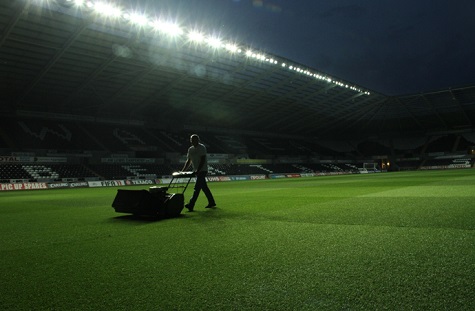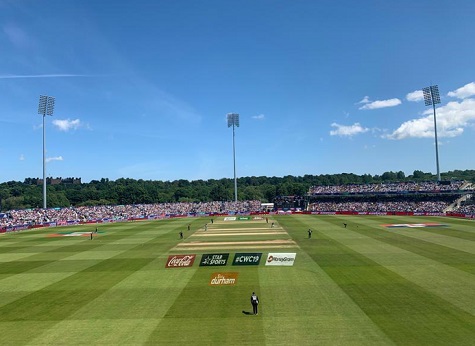At this time of the year it is always good to reflect on how the year has been in terms of achievements and any new milestones you have accomplished. Like most years, it comes with many challenges especially when having to work under pressure from outside influences.
A lot of people who watch sport often do not have an inkling of what is involved in preparing a top-level sports pitch. They will just see the end product and then moan when the result doesn’t go their way.

There will always be some criticism after a poor result, especially now we have umpteen TV camera angles to view from - thus enabling so-called experts and commentators to have their say on the result of the match.
Quite often the performance of the pitch comes into question. I do find it interesting hearing some of their comments about the pitch when, quite frankly, most probably do not have any understanding of the pitch / playing surface in terms of its construction and preparation.
Even away from the glare of the TV, most sporting venues get short shrift from players and managers when the result does not go their way. And usually it is the groundsman who receives the brunt of their anger and disappointment.

This can be common across sports as diverse as bowls, football, rugby, cricket, tennis or golf - with issues being more complex the higher the level of sport being played. Professional groundsmen and greenkeepers may have to deal with a lot of criticism throughout their career.
I personally do not know of any groundsmen who intend to produce a bad pitch. They all want to produce the best surface they can, with the resources they have to hand.
I genuinely feel sorry for both our cricket groundmen and golf greenkeepers who seem to be at the forefront for blame when either the batsman or golfer has a bad day at the office.
Having talked to many high profile groundmen, they themselves do not know, accurately, how the playing surface will perform on the day. This will be due to the many unforeseen influences that can change the surface’s playing characteristics.

We are talking of many variables that can influence the surface. Let’s take cricket first. Most first class wickets are chosen a year in advance of the match. That eventual wicket will be subjected to a lot of work and variable weather fronts. Factors which need to taken into account include how successful the end of season renovations were; seed germination rates; pre-season rolling programmes; spring renovation work; pitch covering; feeding programmes; and finally how good was the 10-14 day preparation of this wicket? These elements will be doupled with the weather, rolling and any watering it might have to endure before the match.
The availability of the right machinery, time and resources will also dictate the outcome of the playing surface. Working with the weather and timing of feeding, weeding and pest / disease controls will also influence the outcome.
No cricket groundsman, to my knowledge, has a crystal ball. They all have to work with these parameters and hope on the day, based on their dedication, skills, knowledge and experience, that they will produce a wicket that is conductive, safe and consistent for both batsman and bowler - and above all, provide an entertaining spectacle for all watching.

Even talking to Vic Demain at Durham CCC, he said that during the England v New Zealand World Cup ODI Match the playability of the pitch appeared to change after 20 overs, yet he himself could not fathom what had changed.
Again, too many variables to ascertain. Was it poor player performance, the condition of the pitch or indeed the condition of the ball?
And yes, they do change the balls during the match, but how long does a ball last? Are they as hard as they used to be? Are they as durable? Do they break down more quickly? It throws another can of worms into the equation.
Far too often the groundsmen become the scapegoat and generally pay the price for controversy in the long term.
As an ex-greenkeeper myself, I am only too aware of the stick greenkeepers get when someone has had a bad game of golf. Golf members also tend to complain too often about the state of the course, especially when they cannot use their trolleys / carts or get stuck in a bunker.

Greenkeepers are truly dedicated to keeping their coursees open 365 days a year and are constantly trying to improve the course in every aspect. For example, improving greens, tees and fairways with the resources they have available.
Again, they are governed by the weather and must maintain the course to the best standard they can. However, this can often be dictated by the level of play required by the membership and the club aspirations. That said it is often the quality of the greens that will dictate the success of the club and the often the reputation of the greenkeeper.
Maintaining golf greens is one of the hardest skills to learn and often takes years to perfect. No two golf courses are the same. Every green has its own microclimate and underlaying soil rootzone composition that needs micro-managing.
As with any natural turf surface it can take a while to establish and takes a series of annual maintenance operations to maintain and sustain plant health, while at the same time trying to achieve a sustainable playing surface that accommodates the needs of its members.

Green speeds are often described as the poisoned chalice for many greenkeepers. It really is about the club agreeing with its members the most appropriate green speed for their ability and the sustainability of the course. Chasing fast green speeds can often have a detrimental effect on both players and the sustainable condition of the greens. And in the past, it has been the catalyst for many a greenkeeper to be discharged from duty.
The same can be said for other sports such as bowls, tennis, football and rugby - producing a decent playing surface requires skills, knowledge, experience and determination.
Slowly but surely, we are finally, at some levels of sport, seeing the appropriate recognition these dedicated groundmen and greenkeepers deserve - both in terms of pay and respect.
I personally believe we need to get many of our topflight groundsmen into the TV spotlight, giving them the opportunity to sit next to the presenters and commentators and talk passionately about the surfaces they are preparing for the given sport being televised.
I am sure it would make good TV and give us a platform to enthuse the next generation of aspiring groundsmen and greenkeepers to come and work in this fabulous, diverse and engaging industry.